
Based on helping companies with major algorithm updates, I often have site owners reaching out about big drops in traffic (whether that’s from broad core updates, other major algorithm updates like the Product Reviews Update, technical problems, or other disturbances in the SEO force). When those drops happen, site owners are often extremely confused about why their site dropped in rankings and traffic. It’s not long into those conversations that I bring up the differences between relevancy adjustments, intent shifts, and overall site quality problems. It’s extremely important for site owners to understand the differences between those three scenarios, and to understand which one (or which combination) is impacting their site.
I think many people jump to quality problems as the main culprit when they drop during a broad core update, and that can definitely be the case, but relevancy adjustments and intent shifts can also cause big drops in rankings and clicks from Google. The main difference is that site owners don’t have much control over relevancy adjustments and intent shifts. And for relevancy adjustments, it might not be a big deal at all for the business, since the quality of traffic from those lost queries can often be very low. In other words, those users weren’t really finding what they needed, they weren’t converting, and it makes sense for Google to show other sites with more relevant content in the search results.
When speaking with clients about the differences between relevancy adjustments, intent shifts, and overall site quality issues, I sometimes joke that I should just write a blog post covering the topic (since I’m explaining it so often and it would be great to point them to an article about it). Well, here it is! :)
In this post, I’m going to explain more about each of the three scenarios (relevancy adjustments, intent shifts, and overall site quality problems). My hope is that it can help site owners understand more about the drops they are seeing based on Google’s broad core updates. And as I said earlier, you could also see a combination of reasons why a site drops. That’s why understanding which queries and landing pages dropped is incredibly important. That’s a good segue to Delta Reports.
But first, here’s a quick table of contents in case you want to jump around the post:
- The Importance of Running Delta Reports.
- Relevancy Adjustments and Broad Core Updates.
- Intent Shifts: A Slightly Different Way For A Site To Lose Search Visibility.
- Overall Site Quality Problems.
- The Good News: Site Owners Can Improve Site Quality.
- Key Points and Recommendations for Site Owners.
First, The Importance of Running Delta Reports for Broad Core Update Drops:
When a broad core update rolls out and you see a drop, it’s always important to analyze which queries and landing pages dropped. That can tell you a lot about why that drop happened. That’s why I recommend running what I call a Delta Report, which shows you the drop across queries and landing pages when comparing the timeframe after the broad core update to a timeframe before. You can read my blog post to learn how you can automate running a delta report (along with filtering that data) via the Search Console API and Analytics Edge.
Once you dig into the data, you might come across several different scenarios. I’ll cover each of those below, starting with relevancy adjustments.
Here are sample screenshots from running a Delta Report in Excel using Analytics Edge:
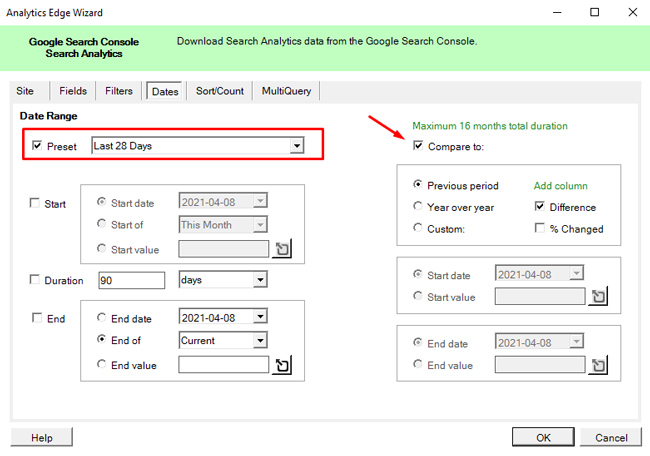

Relevancy Adjustments and Broad Core Updates:
So, what is a relevancy adjustment?If you check the queries that dropped based on a broad core update and notice queries your site really shouldn’t have ranked for, then that could be due to a relevancy adjustment pushed by Google. In other words, some content Google once believed was relevant for the query, is not anymore. This can happen in several ways, and I’ll cover two different types of relevancy adjustments below.
The “You’re On Borrowed Time” Scenario:
First, Google might push an adjustment and a site might not rank anymore for content that it had no right ranking for in the first place. Maybe it’s just content that can’t meet user expectations anymore based on query, or maybe it’s not even on-topic at all. The content might be fine quality-wise, but it just doesn’t help users based on query.
And yes, this can happen…. Google can get it wrong, and it can figure that out over time. Then a relevancy adjustment gets pushed, and boom, the pages drop heavily in the search results for those queries.
Here is an example of a query from a site hammered by the June 2021 broad core update. This is for a specific query that dropped based on a relevancy adjustment. There were many like this for the site…
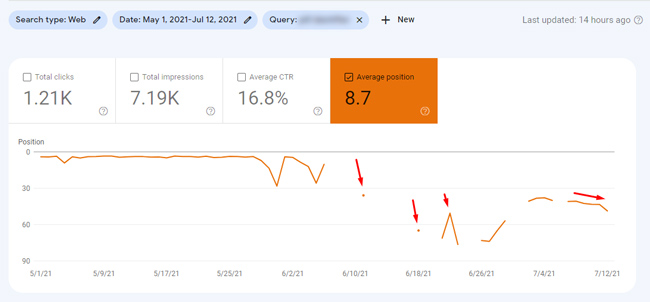
And here is another query (from a different site) that dropped heavily based on a relevancy adjustment with the November 2021 broad core update:
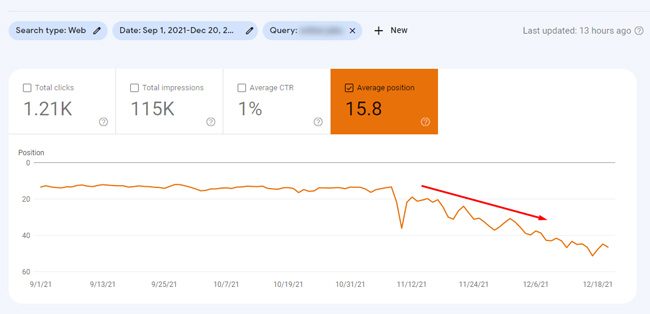
The “Stale and Dated” Scenario:
Another example of a relevancy adjustment is when content was once relevant to a topic but isn’t anymore. I see this often when news publishers have an article about an entity (like a celebrity, politician, company name, etc.) and the content is a few years old and just not relevant anymore. When that relevancy adjustment gets pushed by Google, those articles can drop heavily in the SERPs. It’s not that the content is bad or low-quality, it’s just not relevant anymore. I have covered this many times in my posts about broad core updates.
Here is an example of a query that fits this scenario. It’s a high-quality article that just isn’t relevant to a head term for a celebrity. The “Stale and Dated” scenario can happen often across publishers that write about celebrities, politicians, actors, companies, etc.
For example, here are two examples of stale and dated content dropping during the November 2021 core update and the June 2021 core update.
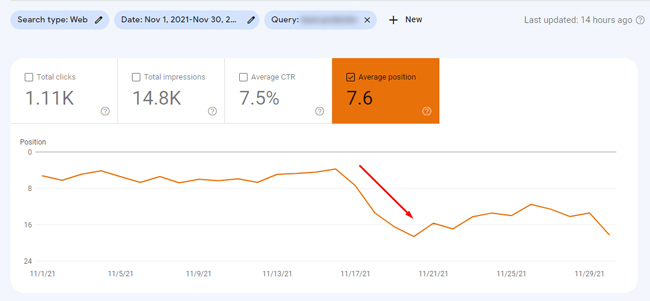
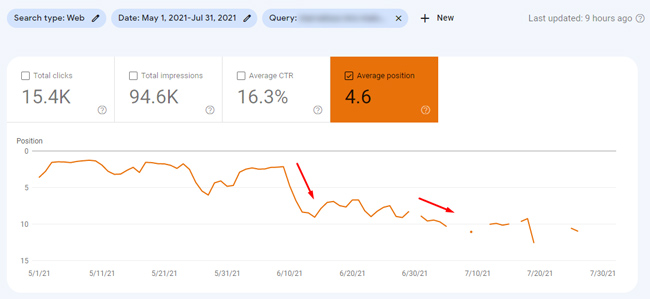
Intent Shifts: A Slightly Different Way For A Site To Lose Search Visibility
What is an intent shift? An intent shift is when Google decides to show different types of content for the queries you once ranked for (based on what it believes users want to see). In other words, Google is trying to determine the intent of the user, which can radically change the search results for those queries. Yes, your content might still be high quality, but Google believes another type of content should rank. And when that happens, your rankings and traffic could plummet (causing huge problems for your business). We actually just saw this happen with the December Product Reviews Update, and I covered intent shifting in a section of that article. More about this soon.
For example, maybe you once ranked for the query “widget name” and you had content covering all of the best deals about the widget, but now Google returns content covering how to use the widget instead based on what it believes users want to see. It’s not that your content was bad, it just doesn’t cover what Google wants to return for users now. And from a content strategy standpoint, maybe you don’t have content covering how to use the widget, so now your site doesn’t rank at all. By the way, Google is making those changes based on the vast amounts of data is sees on a regular basis for those queries. Unfortunately, you can’t control an intent shift.
Like relevancy adjustments, intent shifts can cause big drops for certain sites. Circling back to the December Product Reviews Update, I saw intent shifting happening during the rollout (pretty heavily as the update rolled out over three weeks). For some product queries, Google was either returning review sites or e-commerce retailers (where you could buy the product). So, review sites ranking in the top ten suddenly dropped and retailer websites took their positions.
It’s not that the reviews content was bad, it was just Google believing users want to see places to buy the product for those queries versus the various deals. Again, that shift is completely out of the control of site owners. That said, you can make sure you have content that can rank for other types of search intent, but you can’t force Google to reverse the shift.
Here is an example of a query that was impacted heavily when intent shifts occurred during the December Product Reviews Update (and caused serious volatility for the site jumping into, and out of, the top 10):
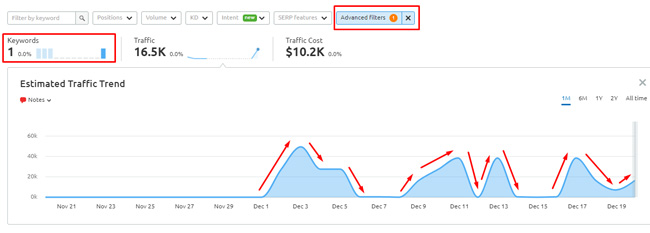
Here is an example of a site impacted by the December 2020 broad core update and there was an intent shift for some queries (where Google started surfacing different types of content in the top ten). The site dropped to the bottom of page one, or even page two, for the query.
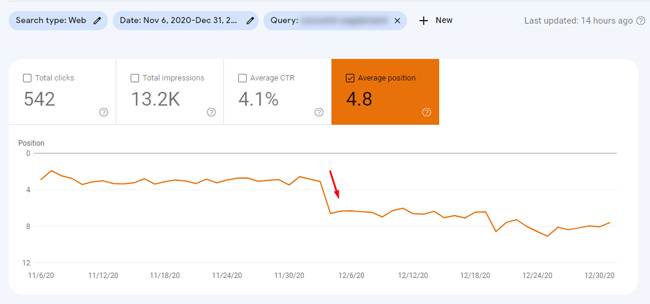
And here is an example of a query where a big intent shift rocked a site (outside of a broad core update). This caused big problems for the site traffic-wise, but eventually Google reversed some of this. They are in much better shape now, but that initial intent shift was substantial for the site.
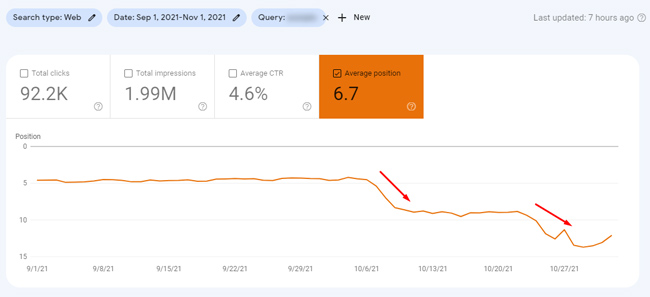
Overall Site Quality Problems:
Beyond relevancy adjustments and intent shifting, overall site quality problems can be an important reason why sites drop heavily during broad core updates. I have covered this many times in my posts about broad core updates, so I won’t go too deeply in this post. You can just read those other posts to learn more about the various quality problems that can cause serious issues for a site when broad core updates roll out. That said, I will cover several key points below.
But first, here are two examples of drops for sites impacted by broad core updates (and both sites had serious overall quality problems). The first was heavily impacted by the May 2020 broad core update and the second was heavily impacted by the June 2021 broad core update. As you can see below, when major quality problems creep into a site, it can cause a big drop in rankings when broad core updates roll out. Site owners obvious want to avoid this at all costs…
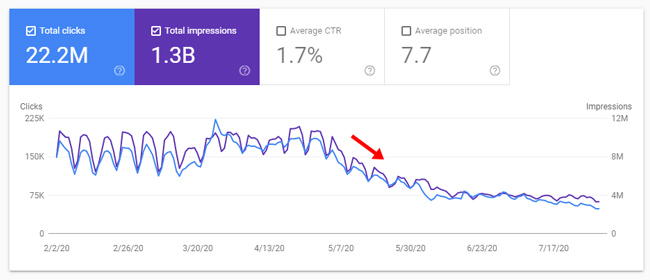
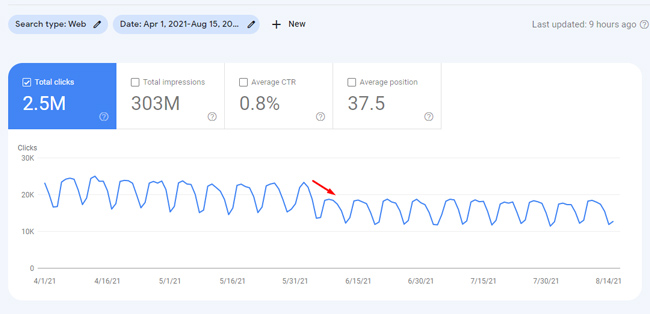
And as I explained earlier, there could be a mix of reasons why a site dropped. For example, here is a site that dropped heavily with the December 2020 broad core update that had site quality problems, but also saw relevancy adjustments that caused drops. That combination was not good for this site (although the relevancy adjustments did make sense in my opinion).
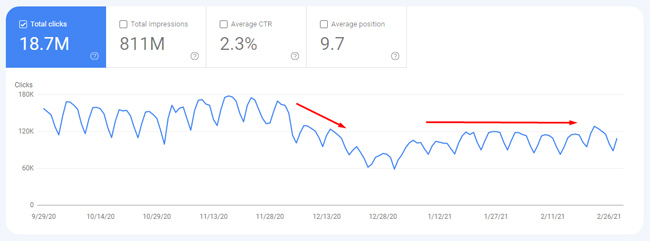
The Good News: Site Owners Can Improve Site Quality.
Here is an example of what can happen when a site significantly improves quality over time (after being negatively impacted by a broad core update). Rankings and traffic can surge when a subsequent broad core update rolls out. The following screenshot is from a site that worked hard to improve quality overall (content quality, user experience, “quality indexing”, toning down its aggressive advertising situation, and more). It surged during the June 2021 broad core update:
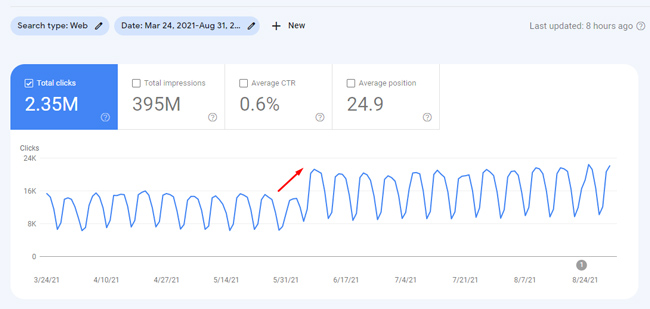
“Quality” is more than just content:
If you think you were impacted based on site quality problems, it’s important to understand that “quality” can mean many things. It’s not just content quality. Google’s John Mueller has explained this before and it’s what I have seen while helping many companies deal with broad core update drops. Google is evaluating the site overall, and over an extended period of time. And quality problems can span several key areas, including content quality, user experience, aggressive, disruptive, or deceptive advertising, aggressive affiliate setups, technical problems that cause quality issues, and more.
Google’s John Mueller explained this during a Search Central hangout. Here is my tweet about that along with a link to the video:
And here is the video clip (at 21:04 in the video):
So, if a site is impacted heavily by a broad core update, and it’s from serious site-level quality problems, then Google will want to see significant improvement in quality over the long-term. This is exactly what Google has explained many times before and it’s what I have seen while helping companies with broad core updates.
Here is John explaining more about this. First, here is one of my tweets covering the topic with a link to the video:
And here is the video below (at 10:52 in the video):
In addition, it’s important to know that you typically cannot recover from a significant core update drop until another broad core update rolls out (if you were impacted due to site quality problems). You might be doing all the right things, improving quality significantly, etc., but you aren’t surging back like you thought you would. That’s because there are site-level quality algorithms that refresh during broad core updates (and that basically hasn’t happened yet). My recommendation is to surface all potential problems impacting a site quality-wise, and address as many as you can. I call this the “kitchen sink” approach to remediation, and it has worked well over time for my clients.
Once again, here is John explaining more about recovery from broad core updates. First, here is my tweet about this:
And here is the video (at 36:45 in the video):
Again, I don’t want to go too deep here about quality, since I’ve written many blog posts that cover quality problems and broad core updates. The core point, pun intended, is that quality problems can cause major issues during broad core updates, and that sites need to address those problems over time. And this is much different than when a relevancy adjustment or intent shift cause drops during broad core updates. You can’t really control those… but you can control site quality.
Analyzing drops from broad core updates: Key points and recommendations for site owners.
I’ll end this post with some key points for site owners that saw a drop during broad core updates. Following the recommendations below can help get you moving on the right direction (and help you understand the core reason you were negatively impacted).
- If you’ve been negatively impacted by a broad core update, then run a delta report to understand the queries and landing pages seeing the biggest drops. I would start here to gain visibility into the queries and landing pages that saw the biggest drops.
- When reviewing those queries, determine if those are relevancy adjustments, intent shifts in the SERPs, or if there might be site-level quality problems causing the drop. And remember, you could be seeing a combination of reasons for the drop. For example, some relevancy adjustments, but some big quality problems too.
- If there were relevancy adjustments, then that’s not necessarily a bad thing (as I covered earlier). There are also times you can create content that is more relevant to those queries (or boost the content that wasn’t meeting user expectations). So, you might be able to regain some of the lost rankings and clicks with content that’s more relevant to the query.
- If there was an intent shift, then determine if you have content that can cover the types of content that Google is now surfacing for those queries. And if you want to be proactive, make sure your content strategy covers various user intents from the start… Then you can potentially have that content rank if an intent shift impacts queries you currently rank for.
- If you determine that the queries dropping are important queries for your site, and you have content that’s relevant to those queries, then it could be site-level quality problems causing issues. If that’s the case, then work hard to improve site quality over the long-term. Understand that you probably will not see recovery until another broad core update rolls out (and it could take several broad core updates to see improvements). You can read my posts about broad core updates for more information about quality problems.
- From a quality standpoint, it’s important to understand that Google is evaluating the site overall (and it’s beyond just content quality). Objectively analyze your site through the lens of broad core updates, surface all potential quality problems, and form a plan of attack for addressing as many as you can. Again, I call this the “kitchen sink” approach to remediation.
Summary: Determining the reason for a broad core update drop can put you on the right path.
I hope this post was helpful for understanding the differences between relevancy adjustments, intent shifts, and overall site quality problems (as they relate to broad core updates). If you have seen a drop during a broad core update, I recommend following the steps I included in this post and determine why that drop happened. For example, did Google push a relevancy adjustment, was there “intent shifting” going on in the SERPs, or does your site have serious overall quality problems? Once you gain clarity, you can determine a solid plan of attack. And remember, start by running a delta report… It can get you on the right path. Good luck.
GG
Back to top>>



